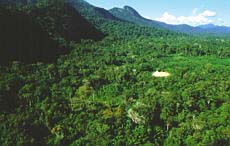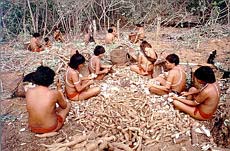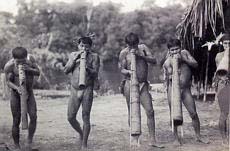|
Exotic Tribes
Be a responsible traveller. Show tribal people respect and meet them on their premises. Visiting people with a different lifestyle and culture could sometimes be a very rewarding adventure, but be aware of that many tribal communities are extremely vulnerable to outside influences. All tribal people need to be protected from tourists in order to preserve their unique lifestyle and cultures. Travellers should understand that some tribes would like to live undisturbed, and that visit would be an intrusion.
Indigenous Populations - Amazon in Brazil
The rich and colourful tribe life in Amazonas in Brazil has fascinated travel explorers for centuries. But how is the native`s life today? Are the still unknown tribes deep in the jungle? Where do you find them?
|
| |
Another 30,000 are Indians who have left their villages
for urban areas. The indigenous population is concentrated
in Amazônia, where around 60% of Brazilian Indians live.
There is great diversity amongst the indigenous societies,
for example, in relation to languages. There are 163
different indigenous languages, and including dialects,
the number rises to 195.
|
 |
Photo:
A Ianomami village, in the Amazon region Antônio
- Ribeiro/Abril Images. |
|
With
the exception of ten isolated languages that are unrelated
to any other, this huge variety of languages can be
divided into 14 groups. Four major linguistic groups
are spread across large areas which can cross national
frontiers: these groups are the Macro-Tupi, Macro-Jê,
Aruak and Karib. The Macro-Tupi and Macro-Jê linguistic
branches cover more than 20 languages each.
Ten
linguistic groups are territorially more compact and
are almost all from the periphery of the Amazon basin,
bringing together a smaller number of languages: these
are the Arawá, Txapakúra, Pano, Guaykuru, Nambikwára,
Mura, Katukina, Yanomami, Tukano and Maku families.
The isolated languages, of which there are ten in all,
are mainly spoken by small groups. But one of them is
spoken by one of the largest indigenous Brazilian groups,
the Tikuna, numbering 20,000 Indians.
Many
languages have become lost during the 20th century and
others are on the verge of extinction. For this reason,
the Pataxó Hã-hã-hãe from south Bahia asked linguists
and anthropologists to prepare a vocabulary with the
co-operation of the last speaker of their language.
It is in the East and North-East regions of Brazil where
most languages have become lost, partly as a result
of prejudice and assimilationist policies. Nowadays,
according to the Brazilian Constitution, teaching in
indigenous areas must be bilingual. The diversity of
indigenous societies - each one being an original synthesis
of sociability and use of natural resources - is an
essential heritage of Brazil.
|
 |
Photo:
StraIanomami Indians preparing the manioc (Rosa Gauditano/AE). |
|
73%
of indigenous populations, that is 152, consist of less
than one thousand people. Forty four groups comprise
between one thousand and five thousand individuals;
four have between five thousand and ten thousand members;
three, between ten thousand and twenty thousand, and
two, between twenty thousand and thirty thousand. Only
the Guarani have slightly over thirty thousand members.
What
is perhaps most striking is the contact between the
simplicity of technology and the richness of the cultural
universes. The indigenous societies have assembled cosmologies
and complex social systems in which non-material heritage
appears to be more favoured than material heritage.
In
relation to private property, for example, it is non-existent
and rights over non-material possessions such as names,
chants and ritual ornaments, are the subject of detailed
regulation. Indigenous art, in turn, seems to prefer
ephemeral support: in many of these societies, the human
body, straw and feathers are the subject of intense
artistic work - body painting, basketry, feather art
- on objects that are essentially ephemeral.
|
 |
Photo:
Cubéus Indians, from the Querari river (Amazon region),
holding the jurupari, a sacred instrument played during
feasts, 1933 Pereira/ Map Collection of the Ministry of
External Relations |
|
According
to the definition of Clause 231 of the Brazilian Constitution,
there are almost one million square kilometres in Brazil
that are indigenous lands, representing around 11.7%
of the nation's total area. These lands are unequally
distributed across the Brazilian territory as a result
of great age and the specific nature of the exploitation
of the regions. For this reason, the lands are concentrated
in Amazônia, where economic exploration is recent or
short-lived. In other words, the Indians were living
in regions that until recently had been of no interest
to anyone or, as in the case of rubber, of no further
interest.
Still untouched tribes
In
Amazônia, contact has been made with 160 such populations,
consisting of around 170,000 Indians and probably a
further 50 groups which have not been contacted. Of
the 554 indigenous areas in Brazil, 364 are in Amazônia.
But those 364 indigenous lands in Amazônia comprise
98.77% of the total area of Brazil's indigenous lands.
With
98,457,455 hectares, they occupy 19.65% of the lands
in Amazônia. The areas already regulated include those
of the Yanomami, in the states of Roraima and Amazonas,
with a total of 9.6 million hectares, those of the Alto
Rio Negro, in Amazonas, and the Kayapó areas in the
state of Pará.
Although
it was predicted during the 1950s and 1960s that the
Indians would disappear, nowadays there is a demographic
recovery and a resurgence of ethnic groups that had
been hiding themselves because of prejudice. Even so,
there are still very few Indians for a great deal of
land, a fact lamented by those believing them to be
hindering the course of development.
The
judgement of values may be reversed as soon as they
know how to evaluate the possible benefits: in the large
areas of Amazônia they occupy, the Indians have preserved
an amazing richness in terms of biodiversity and an
accumulated knowledge that has a hitherto unknown market
value.
The
appropriate assessment of these resources - genetic
diversity and knowledge - and a policy that enables
the continuation of a non-destructive method of exploiting
nature, could guarantee the Indians a future in Brazil
and Brazil the conservation of its cultural and natural
diversity.
Manuela Carneiro da Cunha, 20 May 2001
Additional information
Source for background information: F. Ricardo.
Information
used with permission from the Brazil`s Ministry of External
Relations.
Presentation of the author
Manuela
Carneiro da Cunha is an anthropologist. She was a professor
at the University of São Paulo and is currently a professor
at the University of Chicago. She has served as chairman
of the Brazilian Association of Anthropology and the
São Paulo Pro Indian Commission.
Amongst
other books, she has published Direito dos Índios ("The
Right of Indians") (São Paulo, Brasiliense, 1987) and
was responsible for organizing História dos Índios no
Brasil ("History of the Indians in Brazil") (São Paulo,
Companhia das Letras/ Secretaria Municipal de Cultura/
Fapesp, 1992).
Read
more about exotic tribes on our site. The world is
bigger than you think! |
|
|
|
|
|
Meeting the Mudmen
in Papua New Guinea

See the video HERE |
|
